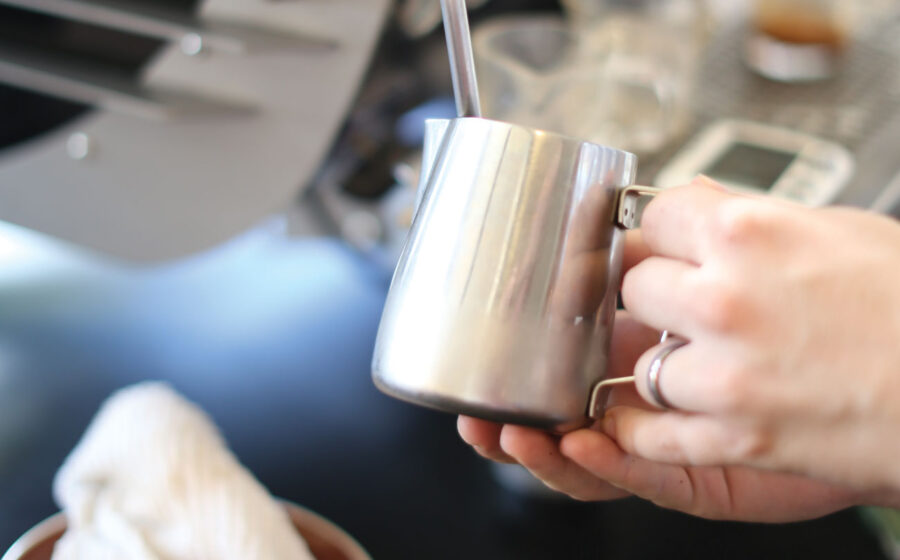[F]or years, how you take your coffee—black or otherwise—has been a litmus test used by many, fairly or not, to assess your commitment to quality. Except in one area: espresso. In the world of espresso-based beverages, milk is a welcome friend, an ally, and an honored ingredient that is treated with respect and care . . . mostly.
Despite the importance milk plays in most café drinks (it’s roughly eighty-three percent of a twelve-ounce latte!), many baristas don’t take the time to pay close attention to this most crucial of ingredients as they steam it.
A few years ago, I walked into a lovely café and ordered a cappuccino. A few minutes later, my name was called, followed by the words, “Cappuccino on the bar!” I left my seat and walked over to the counter to collect my drink. What sat there was not good. Without even getting close to the surface of the froth, I could smell that the milk was burned. The bubbles that constituted the foam were huge, and created an image like the saddest meringue in the world, relegated to sitting unceremoniously on top of a bed of lava-hot milk and coffee. The mug couldn’t even hold all of it, and frothed milk spilled over the side onto the saucer.
My mother taught me to never judge a book by its cover (although Danny, the Champion of the World is just as boring as the cover indicates), so I took a sip, hoping for the best, and expecting exactly what it ended up being—unbearably bad. Here’s the thing: the espresso at this café is actually pretty good. They do a great job roasting coffee, and their blending skills are top notch. How tragic then that the staff in the café doesn’t complement the lovely coffee with milk that is steamed as carefully as the espresso is pulled.
Milk is hugely important. We need to steam it and care for it with that importance in mind.
Just like coffee, freshness matters, and storing milk properly affects freshness. Milk needs to be stored in a refrigerator, and should be returned to the refrigerator right after use. This ensures that not only are your customers getting delicious beverages, they’re getting safe beverages as well.
When it’s time to steam milk for a beverage, grab a pitcher, and pour enough milk so that the pitcher is between one-third and half full, depending on the size of drink you’re making. Then—and this is perhaps the most important thing you’ll read today—purge the steam wand. How? Point the steam wand tip into the drain tray on the espresso machine, or into a bar towel. Now turn it on, wait a second, and turn it off. Done!
It’s tremendously important to purge the steam wand before (and after) steaming for a couple of reasons. First, as steam hangs out in the wand and cools, it condenses into water. That water will be the first thing that shoots out of the steam wand when you turn it on, so unless you want hot water in your fresh, cold milk, a quick purge should eliminate that. Second, when you finish steaming milk, a small vacuum is created that can suck milk into the wand. While most modern espresso machines have systems to keep that milk from traveling all the way back into the steam boiler, there is still hot milk potentially sitting in your hot steam wand. After a few slow minutes on the bar, that milk is definitely not something I want spraying into my next customer’s drink.
With your wand purged, you’re ready to steam some milk. Submerge the end of the wand into the milk, just below the surface, and turn on the steam pressure. Lower the pitcher slightly and aerate (froth) the milk, allowing the steam tip to rest right around the surface of the milk, which creates a sound of rushing air.
Aeration must be complete before 100 degrees Fahrenheit, or when the milk is just warm to the touch. After this temperature, the structure of the foam starts to change into something we don’t want, so once it reaches about body temp, you are done aerating.
Next, submerge the end of the steam wand so that it is well beneath the surface of the milk, but not quite touching the walls or bottom of the pitcher. You’re now going to heat and whip the milk to approximately 150 degrees, which is just beyond the temperature where you can hold your hand against the pitcher. You’ll probably want to adjust the angle of the steam wand to encourage the milk to spin in a vortex, which will whip the texture throughout the milk. When the pitcher becomes too hot to hold, turn off the steam pressure, remove the pitcher, and purge the wand again.
Those are the basics of steaming a single pitcher of milk. It takes practice, and you shouldn’t feel bad if you struggle the first few times. I struggled at first, and so did everyone else. It’s the commitment to sticking with it that makes all the difference.
Next time, we’ll talk more about steaming, and then how to pour that beautiful milk over your perfect espresso to make a beverage that’s “too pretty to drink.”
—Nathanael May is a regular contributor to Fresh Cup. He is Portland Roasting Coffee’s director of coffee.
















